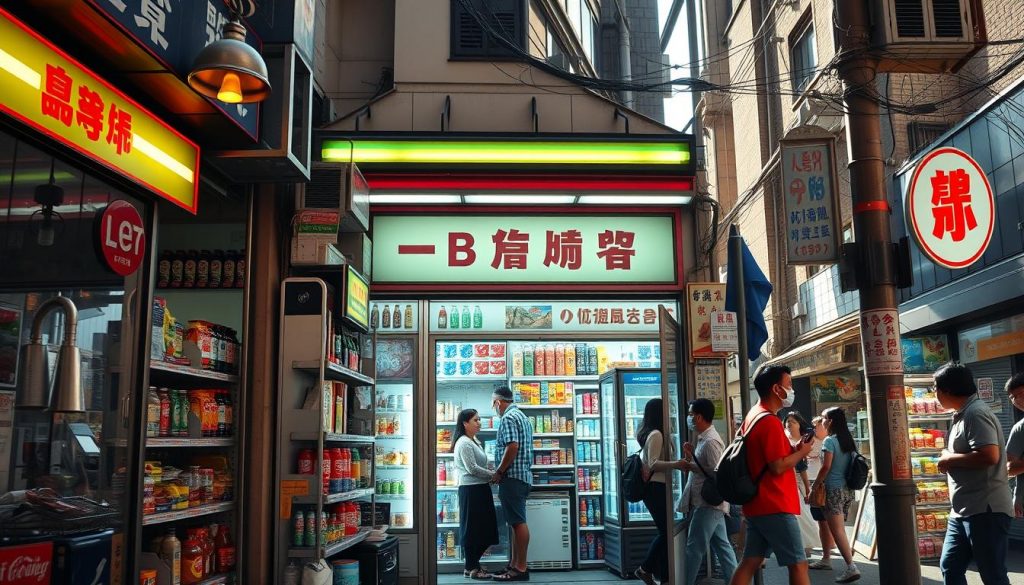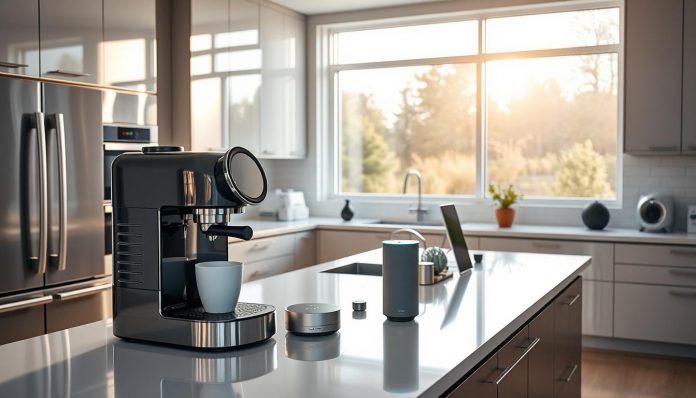Have you ever wondered how modern conveniences have transformed our daily routines? From household innovations to labor-saving appliances, convenience has become a cornerstone of our lives. Today, we explore how these advancements enhance our quality of life and provide practical tips to make the most of them.
The concept of convenience has evolved significantly over the years. What was once a luxury is now a necessity. For instance, 70% of customers are willing to pay more for a convenient experience1, while 75% would switch companies for better convenience1. This shift is evident in the growing popularity of delivery services, which are projected to reach $154.34 billion by 20232.
Convenience stores like 7-Eleven have become integral to our lives, offering everything from groceries to meals. The rise of delivery services has not only saved time but also changed consumer behavior, with 60% preferring delivery for meals2 and 50% favoring local businesses2.
Understanding and maximizing convenience is key to enhancing your daily life. Whether it’s using delivery services or managing your time effectively, this guide will help you make informed choices. For instance, if you’re looking to control appetite and manage weight, natural herbal remedies can be a convenient solution. Visit this resource to explore these options.
Table of Contents
Key Takeaways
- Modern conveniences have revolutionized daily routines, improving quality of life.
- 70% of customers prioritize convenience, willing to pay more for it.
- Delivery services are growing, with a projected market size of $154.34 billion by 2023.
- Convenience stores and delivery services save time, with an average saving of 30 minutes per shopping trip.
- Natural herbal remedies offer convenient solutions for appetite control and weight management.
Understanding Convenience: Definition and Etymology
The concept of convenience has deep roots in history, shaping how we live and interact with the world. To truly grasp its significance, let’s explore its origins and evolution.
Origin of the Term
The word “convenience” traces its roots to the Latin term *conveniens*, meaning “fitting” or “proper.” Initially used in the 14th century, it described situations or objects that aligned with a purpose or need. Over time, its meaning evolved to encompass ease and accessibility, becoming a cornerstone of modern life3.
By 1917, “convenience” had taken on a more contemporary definition, emphasizing time-saving and effort-reduction. This shift marked the beginning of its association with modern innovations and services3.
Key Elements and Characteristics
Convenience is characterized by accessibility, time-saving, and simplicity. It streamlines tasks, making life easier and more efficient. This concept is evident in services like delivery apps and devices that automate routine tasks.
| Aspect | Historical Perspective | Modern Interpretation |
|---|---|---|
| Time-Saving | Focused on labor reduction through basic tools. | Emphasizes efficiency with technology and services. |
| Accessibility | Limited to physical proximity and availability. | Encompasses global reach through digital platforms. |
| Efficiency | Manual processes and early inventions. | Advanced automation and smart solutions. |
This table highlights how convenience has transformed from basic needs to sophisticated solutions, reflecting technological advancements and changing lifestyles.
Understanding the evolution of “convenience” helps frame our discussion on its role in modern life. From its Latin origins to its current applications, this concept continues to shape our world, making it essential to appreciate its depth and impact.
Historical Evolution of Modern Conveniences
Modern conveniences have roots tracing back to early innovations that reshaped household life. The journey from basic utilities to advanced technologies highlights human ingenuity and the quest for efficiency.
Early Household Innovations
The origins of modern conveniences began with fundamental changes in household infrastructure. Basic plumbing and gas lighting marked the starting point, simplifying daily tasks and improving living conditions4.
Innovators like Louis H. Gibson introduced groundbreaking household devices, laying the groundwork for future advancements. These early innovations, though rudimentary by today’s standards, were pivotal in the evolution of convenience.
Transformations in the 20th and 21st Centuries
The 20th century witnessed a surge in household appliance adoption, with refrigerators and washing machines becoming common. These devices significantly reduced labor, revolutionizing home management5.
The 21st century brought smart technologies, integrating automation into daily life. From voice-controlled devices to app-managed home systems, modern conveniences have reached unprecedented levels of sophistication.
| Time Period | Innovations | Impact |
|---|---|---|
| Early 20th Century | Electric Appliances | Reduced manual labor |
| Mid-20th Century | Automated Washing Machines | Saved time and effort |
| Late 20th Century | Microwave Ovens | Quick meal preparation |
| 21st Century | Smart Home Devices | Enhanced efficiency and control |
This table illustrates the progression from basic to advanced conveniences, showcasing how each era built on the last to create the modern home experience.

Understanding the historical journey of modern conveniences provides insight into how these advancements have transformed daily life, from labor-saving devices to intelligent systems that redefine efficiency.
Examples of Service and Product Convenience
Convenience plays a vital role in shaping modern lifestyles, offering solutions that save time and effort. From ready-to-eat meals to innovative devices, these examples illustrate how convenience enhances daily life.
Service Convenience and Time Savings
Service-based conveniences are designed to save time, a precious commodity in today’s fast-paced world. Food delivery services, for instance, allow consumers to enjoy meals without the hassle of cooking, with platforms like DoorDash and Uber Eats leading the way. These services often provide extended hours, catering to late-night cravings or busy schedules, and many accept credit payments for added convenience6.
Another example is the rise of self-service options, such as QR code ordering, which streamlines the process and reduces wait times. This not only enhances customer satisfaction but also helps businesses manage staffing challenges effectively6.
| Service Type | Time-Saving Benefit |
|---|---|
| Food Delivery | Eliminates cooking time |
| QR Code Ordering | Reduces wait times |
| 24/7 Online Scheduling | Accommodates flexible schedules |
These services exemplify how modern conveniences are tailored to save time, fitting seamlessly into busy lifestyles.
Convenience Goods and Labor-Saving Devices
Convenience goods are essential for a faster-paced lifestyle, offering ease and accessibility. Ready-to-eat meals are a prime example, providing quick solutions for busy individuals. These meals are part of the fast-moving consumer goods (FMCG) category, which emphasizes rapid turnover and accessibility7.
Labor-saving devices, such as smart home gadgets, further enhance convenience. These devices automate routine tasks, allowing users to manage their homes efficiently. For instance, voice-controlled devices can adjust lighting or play music, streamlining daily activities without manual intervention8.
These innovations demonstrate how products are designed to minimize effort, making daily tasks more manageable and efficient.
Understanding these examples highlights the significant impact of convenience on time management and lifestyle. By integrating such services and products, individuals can optimize their daily routines, leading to a more efficient and enjoyable life.
Learn moreabout the evolution of convenience products and their role in modern retail.
Impact of Convenience Stores on Daily Life
Convenience stores have become an integral part of modern urban life, offering a wide range of products and services that cater to the needs of busy individuals. These stores operate extended hours, providing easy access to essential items when other retail outlets are closed. Their strategic locations in high-traffic areas make them a convenient option for quick shopping trips, saving customers both time and effort9.
Customer Benefits and Extended Hours
The primary advantage of convenience stores lies in their extended operating hours. Many are open 24/7, allowing customers to purchase groceries, tobacco products, and over-the-counter medications at any time. This accessibility is particularly beneficial in urban areas where residents often have limited time for shopping during traditional business hours9.
Additionally, convenience stores have optimized their layouts to ensure quick access to commonly purchased items. This streamlined approach reduces wait times and makes the shopping experience more efficient. Some stores even offer self-service kiosks and mobile payment options, further enhancing the speed of transactions10.
Operational Models and Challenges
The operational model of convenience stores is designed to meet the demands of a fast-paced lifestyle. They often feature a wide selection of ready-to-eat meals, fresh produce, and other daily essentials. However, these stores also face challenges such as higher per-unit pricing compared to larger retailers and complex logistics due to their frequent restocking needs11.
Despite these challenges, convenience stores continue to evolve by incorporating innovative services. Many now offer financial kiosks, lottery tickets, and even package delivery services. These additional offerings not only attract more customers but also provide a one-stop solution for various needs, making them an indispensable part of urban life11.
| Aspect | Urban Impact | Rural Impact |
|---|---|---|
| Product Availability | Wide range of fresh and ready-to-eat items. | Basic groceries and limited fresh produce. |
| Service Offerings | Financial kiosks, delivery services, and lottery tickets. | Restricted to essential items and limited services. |
| Customer Base | High-traffic areas with diverse demographics. | Smaller, more localized customer base. |
This table highlights the differences in how convenience stores impact urban versus rural areas, emphasizing their role in providing essential services and products to diverse communities.

As lifestyle trends continue to evolve, convenience stores remain at the forefront of retail innovation. Their ability to adapt to changing consumer needs ensures their continued relevance in modern society. Whether through expanded service offerings or strategic operational models, these stores play a critical role in enhancing the quality of daily life for millions of people worldwide9.
Global Perspectives on Convenience and Lifestyle
Convenience is a universal concept, but its interpretation varies widely across cultures and regions. From religious practices to international retail models, the way people embrace modern conveniences is shaped by unique cultural norms and values.
Religious and Cultural Variations
Cultural and religious beliefs significantly influence how convenience is perceived. For instance, communities like the Amish and Mennonites often prioritize simplicity and self-sufficiency over modern conveniences, reflecting their values of tradition and community12. In contrast, urban populations in Asia and Europe have embraced convenience-driven lifestyles, with a strong emphasis on accessibility and efficiency.
Religious practices also play a role in shaping convenience. For example, halal and kosher dietary laws influence the demand for convenient, pre-prepared meals that adhere to religious standards. This cultural adaptation ensures that convenience aligns with deeply held beliefs and practices.
International Retail and Consumer Behavior
Convenience stores and retail models vary significantly across the globe. In Japan, convenience stores like 7-Eleven offer a wide range of fresh, high-quality products, catering to busy professionals. In contrast, European convenience stores often focus on local and organic products, reflecting consumer preferences for sustainability and health13.
Consumer behavior also differs by region. In India, there has been a 45% increase in the use of convenience foods, driven by busy lifestyles and urbanization14. Meanwhile, in North America, convenience stores often serve as community hubs, offering financial services and package delivery in addition to traditional products.
These global perspectives highlight how convenience is shaped by both tradition and innovation. As cultures evolve, so too will the ways in which people embrace and adapt modern conveniences to fit their unique lifestyles and values.
Emerging Trends and Technologies Driving Convenience
Technological advancements are revolutionizing the way we experience convenience in our daily lives. From smart home devices to innovative mobile solutions, these emerging trends are reshaping the landscape of modern convenience, making tasks easier and more efficient than ever before.
Advancements in Home Appliances and Devices
The latest advancements in home appliances and smart devices are setting new standards for convenience. Smart refrigerators now come equipped with features like voice-controlled grocery lists and automated meal planning, streamlining kitchen tasks15. Similarly, voice-controlled devices have become integral to home management, allowing users to adjust lighting, play music, and even monitor security without lifting a finger16.
| Technology | Impact on Convenience |
|---|---|
| Smart Refrigerators | Automated grocery lists and meal planning |
| Smart Speakers | Hands-free control of home systems |
| IoT Devices | Seamless integration of home appliances |
These innovations are not just trendy; they represent a significant shift in how we interact with our living spaces, enhancing efficiency and comfort.
Technological Impact in Underdeveloped Regions
Technology is also making waves in underdeveloped regions, bringing convenience to areas that previously lacked access to modern amenities. Mobile payment solutions, for instance, have enabled millions to access financial services without traditional banking infrastructure17. NGOs are leveraging mobile technology to deliver essential services, from healthcare to education, directly to remote communities17.
These advancements are bridging the convenience gap, ensuring that even in remote areas, people can enjoy the benefits of modern technology, improving their quality of life and economic opportunities.
Conclusion
As we conclude our exploration of modern convenience, it’s clear that this concept has profoundly shaped our daily lives. From the historical evolution of household innovations to the rise of smart technologies, convenience has become a cornerstone of modern living. Today, 70% of customers prioritize convenience, willing to pay more for services that save time and effort18.
Convenience stores and delivery services have revolutionized how we shop and dine. These services not only save time but also cater to diverse needs, from ready-to-eat meals to financial transactions. The global convenience market is projected to grow significantly, reflecting our increasing reliance on these services19.
Global perspectives reveal that convenience is interpreted differently across cultures. While some communities embrace advanced technologies, others value traditional simplicity. This diversity highlights the adaptability of convenience in meeting varied lifestyles.
Emerging trends, such as smart home devices and mobile payment solutions, are further enhancing convenience. These innovations not only improve efficiency but also bridge gaps in underserved regions, ensuring broader access to modern amenities.
Understanding these facets allows us to maximize convenience effectively in our daily decisions. By integrating these insights, we can create a future where convenience continues to evolve and enrich our world.
FAQ
How does convenience impact our daily lives?
What are some examples of service convenience?
How have convenience stores changed over the years?
What role does government play in promoting convenience?
How does technology contribute to convenience?
What are some labor-saving devices in modern homes?
How do cultural differences influence convenience?
What challenges do convenience stores face today?
How has convenience evolved over the past century?
What are the benefits of extended store hours?
How does convenience impact underdeveloped regions?
What is the future of convenience?
Source Links
- What Do Customers Want? Convenience – https://www.cmswire.com/customer-experience/how-to-make-your-customer-experience-better-be-convenient/
- Delivery Services: The Ultimate Guide to Maximizing Convenience – https://biyopos.com/blog/delivery-services-the-ultimate-guide-to-maximizing-convenience/
- Definition of CONVENIENCE – https://www.merriam-webster.com/dictionary/convenience
- The Evolving Kitchen: Modern Conveniences and Historic Character – SALA Architects – https://salaarc.com/blog/the-evolving-kitchen-modern-conveniences-and-historic-character/
- The Evolution of Convenience Food in America – JSTOR Daily – https://daily.jstor.org/the-evolution-of-convenience-food-inamerica/
- Convenience and Today’s Consumer – https://www.getvms.com/convenience-for-consumers/
- Consumer Goods: Meaning, Types, and Examples – https://www.investopedia.com/terms/c/consumer-goods.asp
- Marketing Convenience To The Modern Consumer – https://www.forbes.com/sites/jefffromm/2019/01/04/marketing-convenience-to-the-modern-consumer/
- The Impact of 24-Hour Convenience Stores on Local Communities – https://aithor.com/essay-examples/the-impact-of-24-hour-convenience-stores-on-local-communities
- Convenience stores save time but may be hard on your health – https://www.heart.org/en/university-hospitals-harrington-heart-and-vascular/convenience-stores-save-time-but-may-be-hard-on-your-health
- The Brave New World of Convenience Stores – https://www.hormelfoods.com/inspired/story/the-brave-new-world-of-convenience-stores/
- Global convenience eating. Consumer lifestyle – https://www.innovamarketinsights.com/trends/consumer-trends-global-convenience-eating/
- The evolving concept of convenience – https://www.mintel.com/insights/consumer-research/the-evolving-concept-of-convenience/
- What Drives Consumers to Purchase Convenience Foods? – https://www.usda.gov/about-usda/news/blog/what-drives-consumers-purchase-convenience-foods
- Council Post: The Future Of Technology Integration In Convenience Store Food Service – https://www.forbes.com/councils/forbestechcouncil/2024/03/19/the-future-of-technology-integration-in-convenience-store-food-service/
- The Future of Convenience Stores: How Technology is Shaping the Industry – https://www.linkedin.com/pulse/future-convenience-stores-how-technology-shaping-industry-rapidrms-0felf
- Technology: The Future of Convenience Retail – https://www.convenience.org/Media/conveniencecorner/Technology-The-Future-of-Convenience-Retail
- The Inconvenient Truth About Convenience and Purposive Samples – https://pmc.ncbi.nlm.nih.gov/articles/PMC8295573/
- The Future of On-Demand Drycleaning Services (Conclusion) – https://americandrycleaner.com/node/76261












